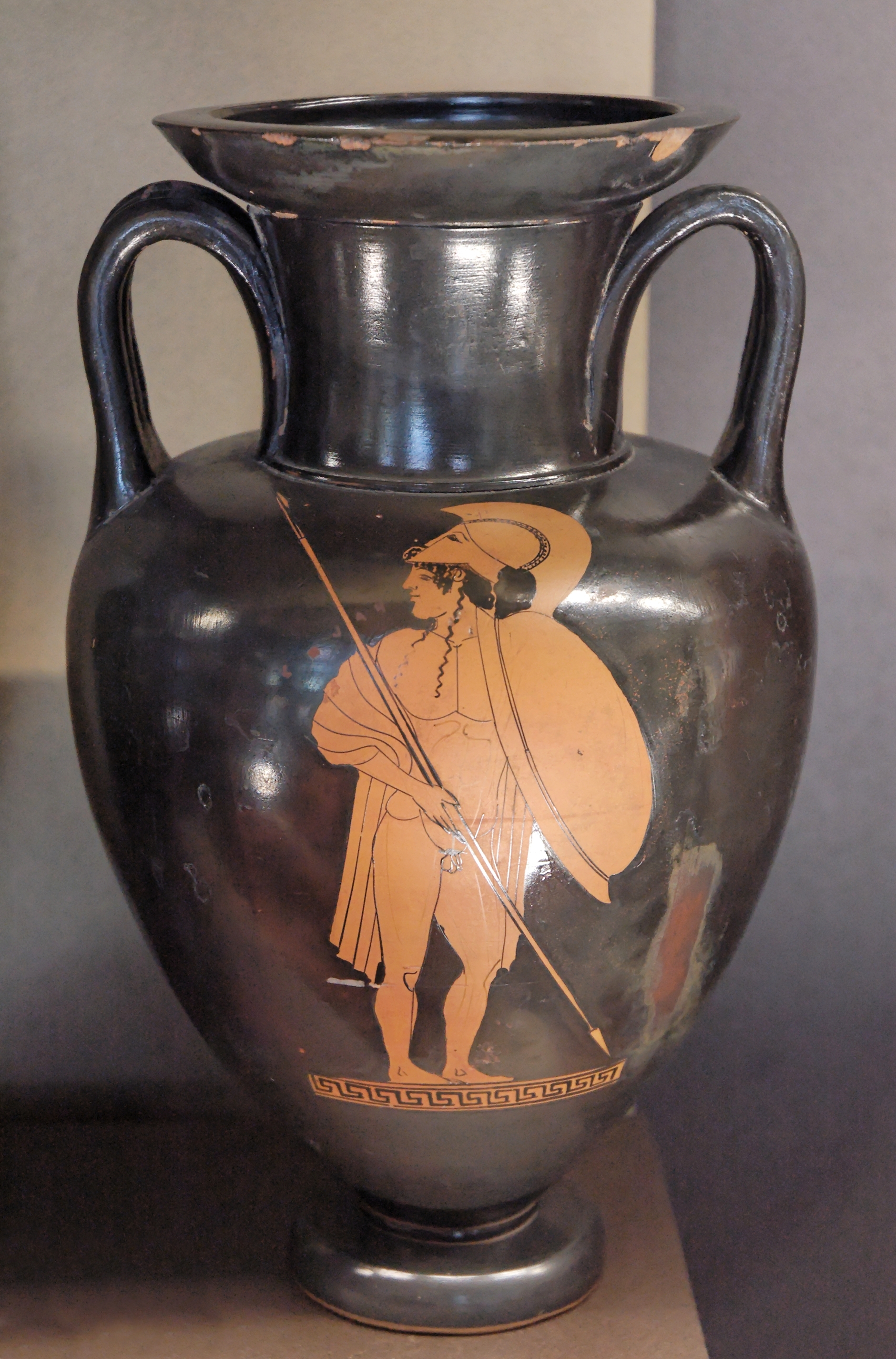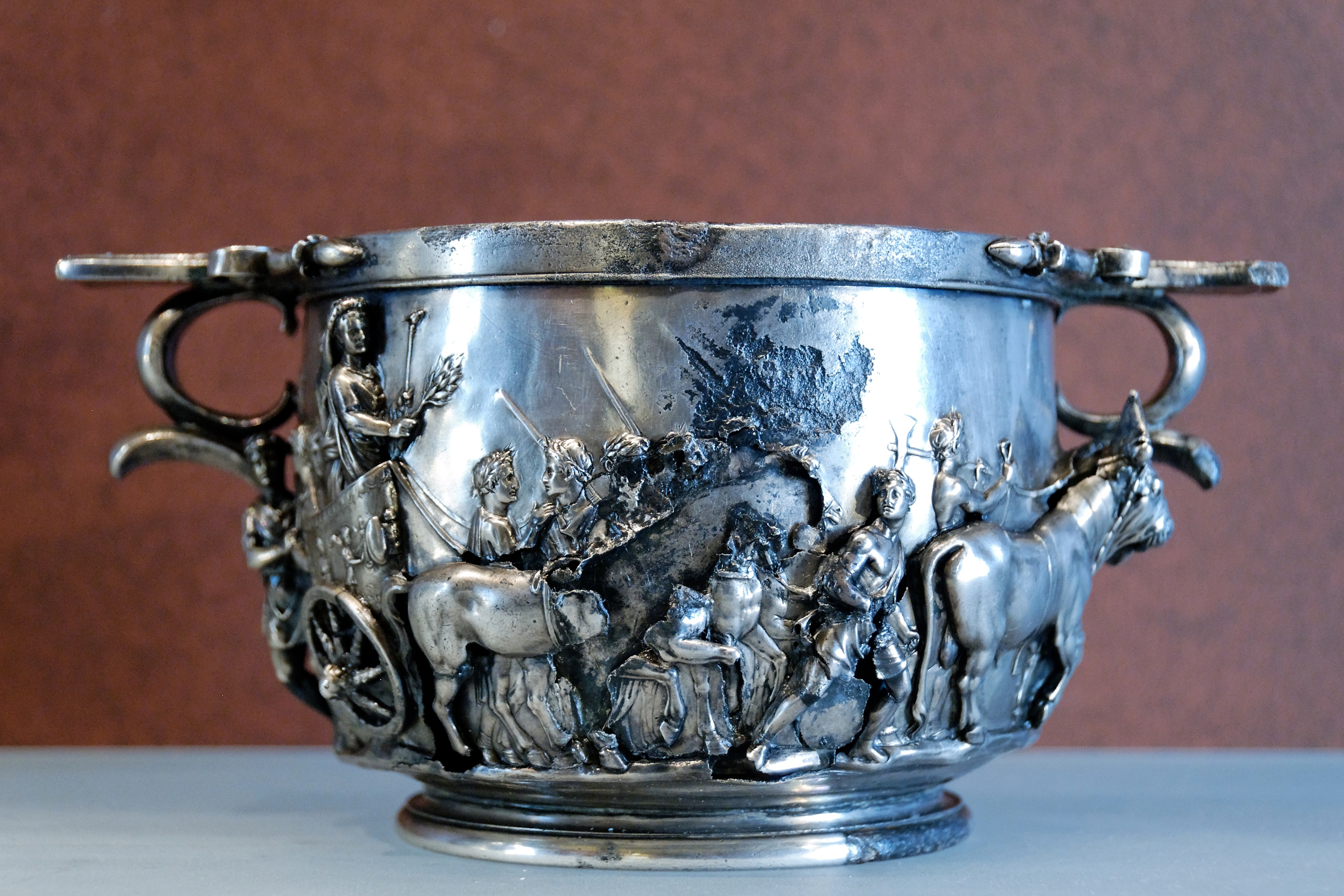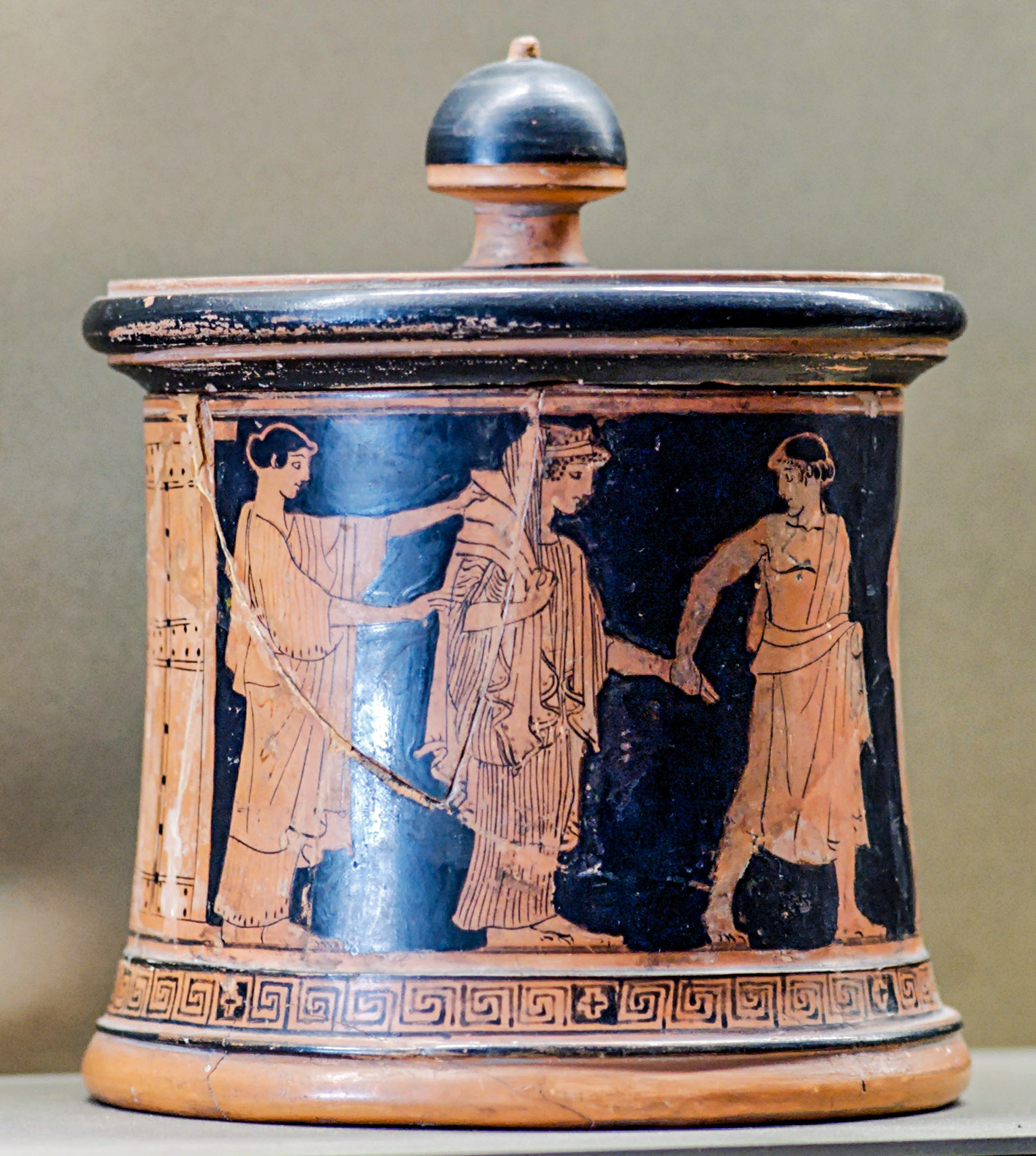|
Typology Of Greek Vase Shapes
The pottery of ancient Greece has a long history and the form of Greek vase shapes has had a continuous evolution from Minoan pottery down to the Hellenistic period. As Gisela Richter puts it, the forms of these vases (by convention the term "vase" has a very broad meaning in the field, covering anything that is a vessel of some sort) find their "happiest expression" in the 5th and 6th centuries BC, yet it has been possible to date vases thanks to the variation in a form’s shape over time, a fact particularly useful when dating unpainted or plain black-gloss ware. The task of naming Greek vase shapes is by no means a straightforward one. The endeavour by archaeologists to match vase forms with those names that have come down to us from Greek literature began with Theodor Panofka’s 1829 book , whose confident assertion that he had rediscovered the ancient nomenclature was quickly disputed by Gerhard and Letronne. A few surviving vases were labelled with their names in antiqu ... [...More Info...] [...Related Items...] OR: [Wikipedia] [Google] [Baidu] |
Neck-amphora Antilochus Louvre G213
An amphora (; ; English ) is a type of container with a pointed bottom and characteristic shape and size which fit tightly (and therefore safely) against each other in storage rooms and packages, tied together with rope and delivered by land or sea. The size and shape have been determined from at least as early as the Neolithic Period. Amphorae were used in vast numbers for the transport and storage of various products, both liquid and dry, but mostly for wine. They are most often ceramic, but examples in metals and other materials have been found. Versions of the amphorae were one of many shapes used in Ancient Greek vase painting. The amphora complements a vase, the pithos, which makes available capacities between one-half and two and one-half tons. In contrast, the amphora holds under a half-ton, typically less than . The bodies of the two types have similar shapes. Where the pithos may have multiple small loops or lugs for fastening a rope harness, the amphora has two expa ... [...More Info...] [...Related Items...] OR: [Wikipedia] [Google] [Baidu] |
Aryballos
An aryballos ( Greek: ἀρύβαλλος; plural aryballoi) was a small spherical or globular flask with a narrow neck used in Ancient Greece."aryballos" in '' The New Encyclopædia Britannica''. Chicago: Encyclopædia Britannica Inc., 15th edn., 1992, Vol. 1, p. 611. It was used to contain perfume or oil, and is often depicted in vase paintings being used by athletes during bathing. In these depictions, the vessel is at times attached by a strap to the athlete's wrist or hung by a strap from a peg on the wall. Versions of the aryballos have been found throughout Greece but some of the more preserved versions have been found within the city of Athens. There are two different versions of aryballoi, the Corinthian version and a version created by Attic potters. The Corinthian version of the aryballos has a rounded base and has one handle which reaches from the shoulder of the base to the lip. The version that was made by Attic potters usually is suited with two handles and ha ... [...More Info...] [...Related Items...] OR: [Wikipedia] [Google] [Baidu] |
Rhyton
A ''rhyton'' (: ''rhytons'' or, following the Greek plural, ''rhyta'') is a roughly conical container from which fluids were intended to be drunk or to be poured in some ceremony such as libation, or merely at table; in other words, a cup. A ''rhyton'' is typically formed in the shape of either an animal's head or an animal horn; in the latter case it often terminates in the shape of an animal's body. ''Rhyta'' were produced over large areas of ancient Eurasia during the Bronze Age, Bronze and Iron Ages, especially from Iran, Persia to the Balkans. Many have an opening at the bottom through which the liquid fell; this could be either for pouring libations, or as a way of drinking. Others did not, and were merely used as drinking cups, with the characteristic, shared by many early cup forms, that they were "unstable" and could not usually be set down on a surface without spilling their contents. The English word wiktionary:rhyton, ''rhyton'' originates in the ancient Greek l ... [...More Info...] [...Related Items...] OR: [Wikipedia] [Google] [Baidu] |
Skyphos
A skyphos (; : skyphoi) is a two-handled deep wine-cup on a low flanged base or none. The handles may be horizontal ear-shaped thumbholds that project from the rim (in both Corinthian and Athenian shapes), or they may be loop handles at the rim or that stand away from the lower part of the body. Skyphoi of the type called'' glaux'' (owl) have one horizontal and one vertical thumbhold handle. Examples Early skyphoi were made during the Geometric period. Corinth set the conventions that Athens followed. Over a long period the shape remained the same while the style of decoration changed. Skyphoi were also made of precious metals, generally silver and gold leaf, many examples exist. One possible, well-preserved example is the Warren Cup,In his notes, John Pollini states that uncertainty about the correct name of many ancient drinking vessels exists, however he refers to the object with the "established classificatory term ''scyphus''", Specifically "half-oval variety of scyphu ... [...More Info...] [...Related Items...] OR: [Wikipedia] [Google] [Baidu] |
Patera
In the material culture of classical antiquity, a ''patera'' () or ''phiale'' ( ) is a shallow ceramic or metal libation bowl. It often has a bulbous indentation ('' omphalos'', "belly button") in the center underside to facilitate holding it, in which case it is sometimes called a ''mesomphalic phiale''. It typically has no handles, and no feet. Although the two terms may be used interchangeably, particularly in the context of Etruscan culture, ''phiale'' is more common in reference to Greek forms, and ''patera'' in Roman settings. The form should be distinguished from a drinking cup with handles, and often a stem, of which the most common type is called a '' kylix'', and a circular platter with a pair of C-handles is not a ''patera'', though a few ''paterae'' have single long straight handles (see ''trulla'' below). Use Libation was a central and vital aspect of ancient Greek religion, and one of the simplest and most common forms of religious practice. It is one of the ... [...More Info...] [...Related Items...] OR: [Wikipedia] [Google] [Baidu] |
Kantharos
A kantharos (; ) or cantharus () is a type of ancient Greek cup used for drinking. Although almost all surviving examples are in Greek pottery, the shape, like many Greek vessel types, probably originates in metalwork. In its iconic "Type A" form, it is characterized by its deep bowl, tall pedestal foot, and pair of high-swung handles which extend above the lip of the pot. The Greek words ''kotylos'' (κότῦλος, masculine) and ''kotyle'' (κοτύλη, feminine) are other ancient names for this same shape.. The kantharos is a cup used to hold wine, probably both for drinking and for ritual use in libations and offerings. The kantharos seems to be an attribute of Dionysus, the god of wine, who was associated with vegetation and fertility. As well as a banqueting cup, they could be used in pagan rituals as a symbol of rebirth or resurrection, the immortality offered by wine, "removing in moments of ecstasy the burden of self-consciousness and elevating man to the rank of ... [...More Info...] [...Related Items...] OR: [Wikipedia] [Google] [Baidu] |
Kyathos
Kyathos (, ) is the name given in modern terminology to a type of painted ancient Greek vase with a tall, round, slightly tapering bowl and a single, flat, long, looping handle. Its closest modern parallel would be a ladle. "The kyathos has a graceful shape resembling a teacup, though a bit larger, with a high looped, flat-strap or oval handle... The terracotta kyathos was used as a ladle for dipping diluted wine from a wine mixer". References Ancient Greek pot shapes {{AncientGreece-stub ... [...More Info...] [...Related Items...] OR: [Wikipedia] [Google] [Baidu] |
Dinos
In the typology of ancient Greek pottery, the (plural '','' known in ancient times as a ) is a mixing bowl or cauldron. means , but in modern typology is used for the same shape as a , that is, a bowl with a spherical body, often accompanied by a wheel-turned stand. It has no handles and no feet. Literary references to such vessels are known from the ''Iliad'', and examples have been found from between the seventh and fifth centuries BCE. Ancient artists who painted include the Dinos Painter, the Gorgon Painter, the Berlin Painter, Exekias and Sophilos. History A was a large, deep bowl, with a round bottom and a wide mouth. were used both for cooking and for mixing wine with water. The term is modern; in ancient Greece, the word was used for a drinking-cup, while the term was used for the rounded bowl. were often made with wheel-turned stands, and could be made either in metal or in terracotta: it is likely that the metal examples were designed for cooking, whi ... [...More Info...] [...Related Items...] OR: [Wikipedia] [Google] [Baidu] |
Krater
A krater or crater (, ; , ) was a large two-handled type of vase in Pottery of ancient Greece, Ancient Greek pottery and metalwork, mostly used for the mixing of wine with water. Form and function At a Greek symposium, kraters were placed in the center of the room. They were quite large, so they were not easily portable when filled. Thus, the wine-water mixture would be withdrawn from the krater with other vessels, such as a (: ), an amphora (: ), or a (: ). In fact, Homer's ''Odyssey'' describes a steward drawing wine from a krater at a banquet and then running to and fro pouring the wine into guests' drinking cups. The modern Greek word now used for undiluted wine, (), originates from the (, ) of wine and water in kraters. Pottery kraters were ceramic glaze, glazed on the interior to make the surface of the clay more impervious for holding water, and possibly for aesthetic reasons, since the interior could easily be seen. The exterior of kraters often depicted scenes fro ... [...More Info...] [...Related Items...] OR: [Wikipedia] [Google] [Baidu] |
Symposium
In Ancient Greece, the symposium (, ''sympósion'', from συμπίνειν, ''sympínein'', 'to drink together') was the part of a banquet that took place after the meal, when drinking for pleasure was accompanied by music, dancing, recitals, or conversation.Peter Garnsey, ''Food and Society in Classical Antiquity'' (Cambridge University Press, 1999), p. 13online Sara Elise Phang, ''Roman Military Service: Ideologies of Discipline in the Late Republic and Early Principate'' (Cambridge University Press, 2008), pp. 263–264. Literary works that describe or take place at a symposium include two Socratic dialogues, Plato's '' Symposium'' and Xenophon's '' Symposium'', as well as a number of Greek poems, such as the elegies of Theognis of Megara. Symposia are depicted in Greek and Etruscan art that shows similar scenes. In modern usage, it has come to mean an academic conference or meeting, such as a scientific conference. The Latin equivalent of a Greek symposium in Roman s ... [...More Info...] [...Related Items...] OR: [Wikipedia] [Google] [Baidu] |
Pyxis (vessel)
A pyxis (Greek: ; : pyxides) is a shape of vessel from the classical world, usually a cylindrical box with a separate lid and no handles. They were used to hold cosmetics, trinkets or jewellery, but were also used for dispensing incense and by physicians to contain medicine. Surviving pyxides are mostly Greek pottery, but could also be made from a range of other materials: wood, bronze, ivory, marble, terracotta, silver, or stone. The name derived from Corinthian boxes made of wood from the tree puksos ("boxwood"). During the Classical period, the Attic word "''kylichnis''" was also used to refer to the same shape. The shape of the vessel can be traced in pottery back to the Protogeometric period in Athens, however the Athenian pyxis has various shapes itself. Types There were many different varieties of pyxis, popular in different times and places. The earliest were the Protogeometric type of vessel which had a globular body, and the pointed-bottom pyxis from the early Ge ... [...More Info...] [...Related Items...] OR: [Wikipedia] [Google] [Baidu] |
Stamnos
A (; plural ) is a type of ancient Greek vase used to serve and store liquids. have a wide mouth, a foot, and two handles, and were usually made with a lid. The earliest known examples come from archaic Laconia and Etruria, and they began to be manufactured in Athens in the middle of the fifth century BCE. Attic , often finely decorated, were mostly made for export to Etruria. They are often found in funerary contexts, and may have been purchased specifically for this use; in vase-paintings, they are often shown being used to mix or serve wine, sometimes with a ladle. They were painted in red-figure, in black-figure and using Six's technique, by artists including Oltos, Euphronios, Smikros, Polygnotos, the Berlin Painter and the Kleophrades Painter. Their manufacture ceased around 420 BCE, possibly due to the reduction in trade between Athens and Italy brought on by the Peloponnesian War and the failure of the Sicilian Expedition in 415–413 BCE. Local ex ... [...More Info...] [...Related Items...] OR: [Wikipedia] [Google] [Baidu] |










